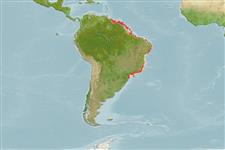Environment: milieu / climate zone / depth range / distribution range
Ekologi
laut; air tawar; payau; anadromus (ruaya dari laut ke air tawar) (Ref. 26213); kisaran kedalaman 1 - 50 m (Ref. 189). Tropical; 9°N - 27°S, 61°W - 33°W (Ref. 189)
Western Atlantic: Orinoco delta in Venezuela south to Ponta da Cotinga, Paraná coast of Brazil.
Length at first maturity / Size / Weight / umur
Maturity: Lm 9.4, range 7 - ? cm
Max length : 18.0 cm TL jantan/; (Ref. 102462); common length : 9.0 cm TL jantan/; (Ref. 5217); Berat maksimum terpublikasi: 32.00 g (Ref. 118626)
Duri punggung (Keseluruhan (total)) : 0; duri punggung lunak (Keseluruhan (total)) : 14 - 17; Duri dubur: 0; Sirip dubur lunak: 19 - 26. Body moderately elongate and compressed (Ref. 189). Snout short, about 2/3 eye diameter; maxilla relatively long, tip bluntly rounded, reaching to pre-operculum; gill cover canals of walkeri-type (Ref. 189). Anal fin fairly long, its origin below about middle of dorsal fin base. A broad silver stripe along flank, equal or greater than eye diameter below dorsal fin (Ref. 189).
A schooling species found inshore. Most likely anadromous, entering estuaries and freshwater. Feeds on crustacean larvae or small invertebrates (Ref. 12225). Female maximum length from Ref. 71685.
Both sexes at maturity have a large amount of visceral and intermuscular fat (Ref. 189). Spawn in school (Ref. 205).
Whitehead, P.J.P., G.J. Nelson and T. Wongratana, 1988. FAO Species Catalogue. Vol. 7. Clupeoid fishes of the world (Suborder Clupeoidei). An annotated and illustrated catalogue of the herrings, sardines, pilchards, sprats, shads, anchovies and wolf-herrings. FAO Fish. Synop. 125(7/2):305-579. Rome: FAO. (Ref. 189)
Status IUCN Red List (Ref. 130435: Version 2024-2)
ancaman kepada manusia
Harmless
penggunaan manusia
Perikanan: nilai komersial kecil
Alat, peralatan
laporan khas
muat turun XML
Sumber internet
Estimates based on models
Preferred temperature (Ref.
123201): 24.5 - 27.8, mean 27.2 °C (based on 68 cells).
Phylogenetic diversity index (Ref.
82804): PD
50 = 0.5000 [Uniqueness, from 0.5 = low to 2.0 = high].
Bayesian length-weight: a=0.00537 (0.00470 - 0.00614), b=3.13 (3.09 - 3.17), in cm total length, based on LWR estimates for this species (Ref.
93245).
Trophic level (Ref.
69278): 3.1 ±0.30 se; based on food items.
Daya lenting (Ref.
120179): Tinggi, Waktu penggandaan populasi minimum kurang dari 15 bulan (Fec=20,202).
Fishing Vulnerability (Ref.
59153): Low vulnerability (10 of 100).
Nutrients (Ref.
124155): Calcium = 273 [153, 637] mg/100g; Iron = 1.9 [1.1, 3.4] mg/100g; Protein = 18.3 [16.9, 19.7] %; Omega3 = 0.306 [0.154, 0.612] g/100g; Selenium = 41.1 [18.3, 94.0] μg/100g; VitaminA = 27.4 [8.1, 73.8] μg/100g; Zinc = 2.03 [1.39, 3.01] mg/100g (wet weight);
